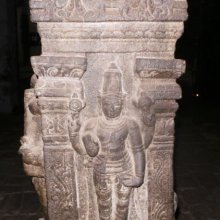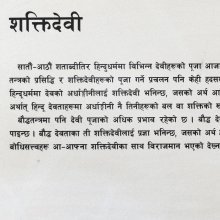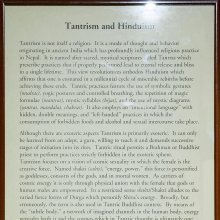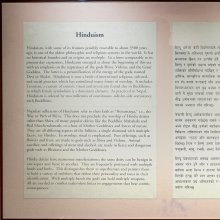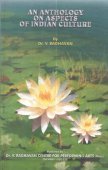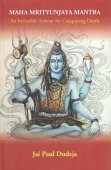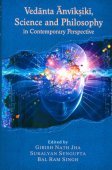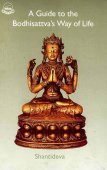Hinduism: 4 definitions
Introduction:
Hinduism means something in Hinduism, Sanskrit, the history of ancient India. If you want to know the exact meaning, history, etymology or English translation of this term then check out the descriptions on this page. Add your comment or reference to a book if you want to contribute to this summary article.
Images (photo gallery)
(+6 more images available)
In Hinduism
General definition (in Hinduism)
Source: WikiPedia: HinduismHinduism : A worldwide religious tradition that is based on the Vedas and is the direct descendent of the Vedic religion. It encompasses many religious traditions that widely vary in practice, as well as many diverse sects and philosophies.
Source: Shodhganga: The significance of the mūla-berasHinduism is the general term for all the forms of worship in which the Hindu religious consciousness has found expression. It has had a significant influence on the structure of Indian life. More significantly, Hinduism teaches Indian aesthetic and emotional culture for spiritual understanding and character development through fine arts like music, dance, drama, painting, and sculpture. Hinduism is also referred to as Vaidika Dharma, meaning “religion of the Vedas,” in the ancient Hindu scriptures. The original name of Hindu Dharma is Sanātana Dharma, or “universal religion”.
Hinduism is a way of life and is based on the practice of dharma, the code of life. The ultimate objective of religion is the realization of truth by getting united with the Supreme Being, Paramātman. There are three distinct aspects in Hindu religious belief: the temples, philosophy and the guru (teacher). In this study the devotee-deity union is centered on the temples.
Hinduism has different sects such as Śaivism (the followers of Śiva), Vaiṣṇavism (the followers of Visnu), Kumāryam (the followers of Murukan), Gaṇ apathyam (the followers of Ganapati), Śaktism (the followers of goddess) and Sūryam (the followers of Sun God). Each sect has numerous images in various forms. Mūrti is the deity of the temple. The deities differ according to the religious faith of the people. Each sect has a philosophy and religion of its own.
India history and geography
Source: archive.org: Social Life In Medieval RajasthanHinduism in Rājasthān.—The Vedic sacrifices, as we have referred to above, were in vogue among the richer sections of society. The available evidence tends to show the orthodox sects, generally termed Hinduism, were, popular in Rājasthān from the early ages. In these sects, worships of Brahmā, Sun, Śiva, Viṣṇu, Rāma and other deities were pre-eminent.
Source: What is India: Inscriptions of the ŚilāhārasHinduism during the reign of the Śilāhāra dynasty (r. 765-1215 A.D.).—Hinduism was in the most flourishing condition in this period. The old Vedic sacrifices had long been out of vogue. There are no references to the performance of such śrauta sacrifices as the Vājapeya and the Aśvamedha in any Śilāhāra inscriptions. The Smṛtis also, which were held authoritative in this period, and their commentaries do not preach the performance of costly Vedic sacrifices. As the Vedic religion lost ground in this period, Purāṇic Hinduism came to the forefront. The worship of Purāṇic gods and goddesses prevailed throughout this period.

The history of India traces the identification of countries, villages, towns and other regions of India, as well as mythology, zoology, royal dynasties, rulers, tribes, local festivities and traditions and regional languages. Ancient India enjoyed religious freedom and encourages the path of Dharma, a concept common to Buddhism, Hinduism, and Jainism.
See also (Relevant definitions)
Full-text (+1542): Brahma, Kathmandu, Himdutva, Meru, Erandapalla, Hindutv, Kantan, Nastika, Kripa, Anyavarna, Buddha, Hiranyaksha, Rakshasa, Pancakanya, Jambavat, Himdu, Mritsuchak, Veda, Mahabhaya, Brahmadharma.
Relevant text
Search found 129 books and stories containing Hinduism; (plurals include: Hinduisms). You can also click to the full overview containing English textual excerpts. Below are direct links for the most relevant articles:
Diaspora of Bhuta (Daiva) worshipping cult—India and Indonesia (by Shilpa V. Sonawane)
Part 3 - Religion and Culture of Bali (Introduction) < [Chapter 4 - Inter-Disciplinary Analysis]
Part 3.1 - Hindu Gods and Goddesses of Bali < [Chapter 4 - Inter-Disciplinary Analysis]
Part 3.3 - Early History of Religion in Indonesia < [Chapter 4 - Inter-Disciplinary Analysis]
Hindu Pluralism (by Elaine M. Fisher)
Sectarianism And Pluralism < [Introduction]
Early Modern Sectarianism and Modern Pluralism < [Conclusion—A Prehistory of Hindu Pluralism]
Early Modern Sectarianism and Modern Pluralism < [Conclusion—A Prehistory of Hindu Pluralism]
Hinduism: The Golden Thread of Indian History < [January – March, 1979]
Openness is The Essence < [April – June, 2007]
Scientific Approach to Hinduism < [July 1964]
Jainism in Odisha (Orissa) (by Ashis Ranjan Sahoo)
Introduction < [Chapter 1]
Chapter 2: The origin of Jainism in Odisha (Orissa)
Jaina Antiquities in Dandapalasa (Balasore) < [Chapter 3: Survey of Jaina Antiquities in Odisha]
Formal Education System in Ancient India (by Sushmita Nath)
Buddhist Educational Rituals (Introduction) < [Chapter 2 - Rituals of the Education System]
Meaning of the word Saṃskāra < [Chapter 2 - Rituals of the Education System]
Bhagavatpadabhyudaya by Lakshmana Suri (study) (by Lathika M. P.)
The Socio Spiritual Conditions of 8th Century AD < [Chapter 3 - References to Śaṅkara’s Philosophy]
The Changing Brahmanical Attitude towards Buddhism < [Chapter 3 - References to Śaṅkara’s Philosophy]
Śaṅkara’s Metaphysics < [Chapter 3 - References to Śaṅkara’s Philosophy]
Related products
(+2 more products available)
